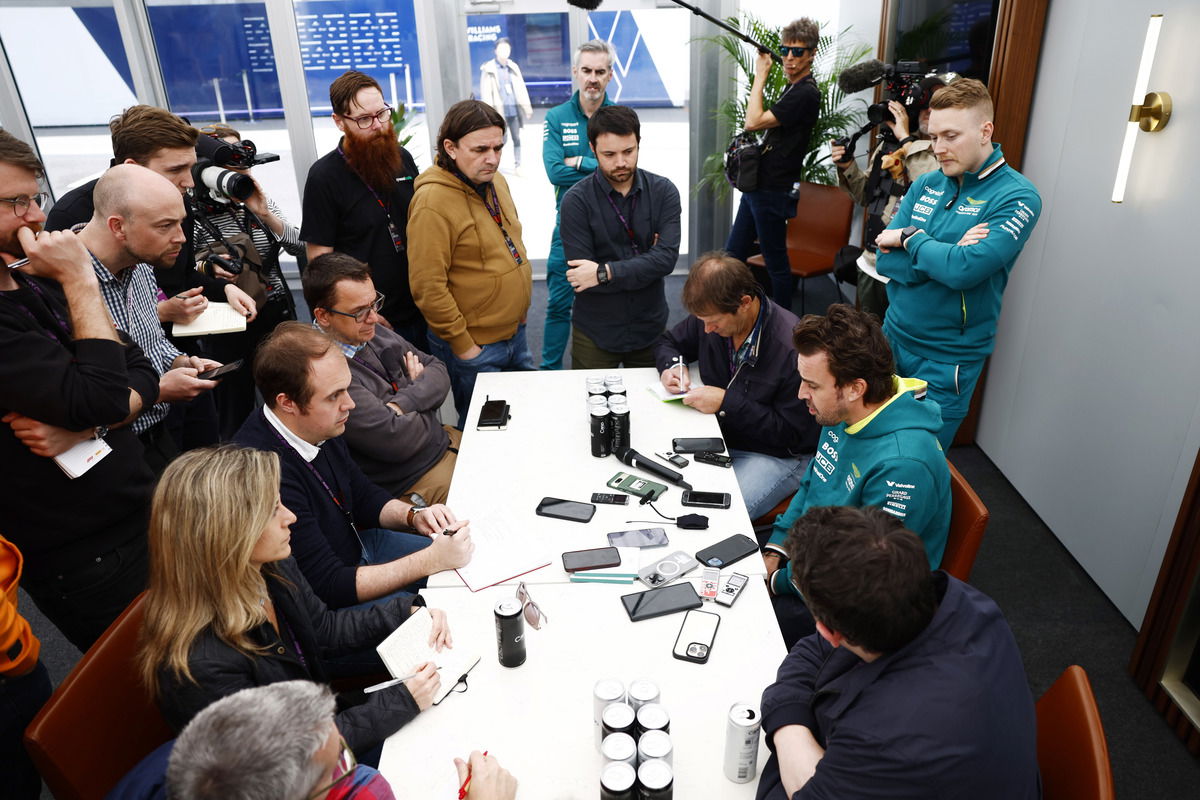

Alonso was handed a 20-second post-race penalty for ‘potentially dangerous driving’ for his actions when defending from Russell approaching Turn 6.
The Spaniard was found to have lifted off the throttle and slightly brushed the brakes, and dropped a gear, 100 metres before the usual braking zone for the corner right-hander.
It was done in an effort to wrong-foot Russell and increase the gap heading onto the DRS-enabled blast down Lakeside Drive.
Surprised by the move, the Mercedes driver left the road, crashing heavily in an impact that left him broadside across the middle of the track.
Stewards investigated the incident post-race and found Alonso’s actions to be in breach of the Sporting Regulations, a penalty Alonso disagrees with.
“It was a bit surprising, the penalty in Melbourne, but nothing we can do,” he said in Japan.
“It will not change much on how we drive, how we approach racing.
“There is no obligation to drive 57 laps in the same way. Sometimes we get slower pace to save fuel, to save tyres, to save battery.
“Sometimes we get slow into corners or into some sectors of the track to give the DRS to the car behind because that will be a useful tool if the second car behind is at a faster pace.
“All those things are completely normal. It was, it is, and it will be forever in motorsport.
“If it was in Abu Dhabi with a run-off area in asphalt or whatever, I think George will rejoin the track a few metres after that and will try to have a go on me in the following lap, or in the following straight. It will not be any problem,” he added.
Russell explained that he hadn’t noticed Alonso’s action initially as he was making adjustments to his car.
“I was actually looking at the steering wheel, making a switch change in the straight, which, you know, we all do across the lap,” he explained.
“When I looked up, I was in Fernando’s gearbox, and it was sort of too late. And then next thing I know, I’m in the wall.”
Russell was critical of the FIA’s response in the seconds after the crash, suggesting it took too long for the Virtual Safety Car to be deployed – which took approximately 12 seconds.
Speedcafe understands that, yellow flags were waving in the sector before the Mercedes had reached the barrier in the first instance.
Race control ordered double-waved yellows in five seconds and single yellows in the sector preceding the incident within seven seconds.
Officials deemed that the crash was in response to Alonso’s actions but was not directly caused by them, but still punished the Spaniard. It’s that point that has drivers divided.
“Obviously, George had a massive crash because of, a little bit, Fernando’s defence strategy,” Daniel Ricciardo explained.
“So because of that, you’re like ‘Okay, that was bad’. But then again, if George didn’t crash, then maybe nothing happens.
“I’ll be honest, I haven’t seen the data or I don’t know if he just lifted early or what. But if he was kind of suddenly braking in a straight line, then I’m definitely not condoning that.
“If it’s just that he lifted off a bit earlier and tried to just distract George a little bit, then that’s obviously one that maybe you’re going to have 50/50 for and against.”
Oscar Piastri holds a firmer opinion, suggesting Alonso was hard done by in Melbourne.
“Giving a penalty for it potentially creates a very, very tricky precedent for everybody,” he reasoned.
“Giving a car a penalty for no contact, and I mean, quite frankly, it wasn’t a crash out of avoidance…
“I could understand that if George was trying to avoid Fernando and had to swerve off the track, then, yes, understandable. But giving someone a penalty for causing dirty air? I’m sure a lot of qualifying sessions would go very differently if we started doing that.
“So I was a bit surprised by the penalty.”
Nico Hulkenberg did not share the McLaren driver’s view, suggesting while Alonso’s tactic is valid, Turn 6 was the wrong place to apply it.
“Melbourne, after all, it’s kind of a street circuit. It’s quite narrow there. We approach that corner with 260 to 70 clicks. It’s a blind exit,” he said.
“That particular corner with that speed, with a blind exit, I think it’s the wrong corner to do it, and it produced quite a dangerous situation.
“I think it’s the wrong speed range, the wrong corner,” he added.
“And I think also the [gear] shift or the change, deceleration was quite a big delta, obviously.
“It’s easy to overreact and lose the rear of the car, like it happened to George.”
However, his own team-mate, Kevin Magnussen, disagrees.
The Dane engaged in similar behaviour during the Saudi Arabian Grand Prix when he ran interference to help protect Hulkenberg’s chances of a points finish.
“I was lifting in places that we would normally be flat,” Magnussen confessed of his Jeddah defence.
“But nobody crashed behind.
“I feel like that was a pretty harsh penalty,” he added of Alonso’s Australian fate.
“I wasn’t in the car, and neither Russell’s or Lance [Stroll] who was kind of close but didn’t look to me like it was solely Alonso’s fault.
“I think it’s just important to have, as we always say, consistency so we can anticipate, so we can drive to the limit of the rules and not overdrive.”
Stroll was the first car on the scene, passing Russell’s stricken Mercedes just after it had come to rest in the middle of the race track.
The Aston Martin driver had been warned on the radio ahead of time and observed the yellow flags, reducing his speed significantly.
“It was pretty sketchy,” the Canadian noted.
“I saw the incident afterwards and I think the end result looked a lot worse than it was.
“But in that instance, a blind corner, you’re not sure why… When a driver’s asking for a red flag, I’ve been in a position like that – I had a puncture in Baku and was in the middle of the track, and it’s similar to the highspeed section George was in.
“Those moments, you don’t want to be sitting there as a driver, I think it’s just easier to red it, red flag it, call it.
“I thought it was ridiculous to be honest,” Stroll added of the penalty his team-mate received.
“I don’t think he did anything stupid. He was just preparing the exit of the corner.
“For me, it was ridiculous [to] get a drive-thru penalty for it incident that doesn’t even involve any contact between the cars or anything like that. So yeah, I didn’t really get to understand it.”
Russell, meanwhile, suggests not penalising Alonso’s behaviour would have set a dangerous precedent and a poor example for the junior categories.
“If it were not to have been penalised, it would have really opened the kind of worms for the rest of the season – and in junior categories – of saying, you know, are you allowed to break in a straight?
“Are you allowed to slow down, change gear, accelerate, do something semi-erratic?
“I don’t take anything personally with what happened with Fernando and it probably had bigger consequences than it should have.
“But, as I said, if it went unpenalised, can you just break in the middle of a straight? I don’t know.
The matter is set to be discussed further as part of the drivers’ briefing on Friday evening at this weekend’s Japanese Grand Prix.





















Discussion about this post